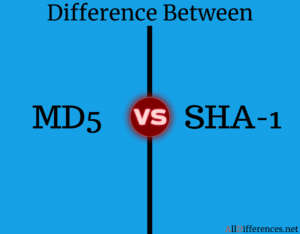Difference Between MD5 and SHA-1 in Tabular Form
Contents
- MD5 and SHA-1 hashing algorithms provide one-way encryption which is ideal for storing passwords as you will not normally need to see the unencrypted version. You just hash the password provided by the user and authenticate it by comparing it with what’s stored in the database.
- MD5 uses a hash length of 16 bytes and SHA1 uses 20 bytes. This means that SHA1 is slower but more secure.

Comparison Chart
| MD5 | SHA-1 |
|---|---|
| It is first published in the year 1992. | It is first published in the year 1995. |
| MD5 length is 128 bits. | SHA-1 length is 160 bits. |
| Speed is faster than SHA-1. | Slower than the MD5 |
| The number of iteration is 64. | The number of iteration is 80. |
| Buffer space is 128 bits. | Buffer space is 160 bits. |
| MD5 is vulnerable to cryptanalytics attacks. | SHA-1 appears not to be vulnerable to cryptanalytics attacks. |
| MD5 uses a little-endian scheme. | SHA-1 uses a big-endian scheme. |
| MD5 has 16 Rounds. | SHA-1 has 20 Rounds. |
| It is less secure | It is more secure |
Message Digest
- A message-digest algorithm is also called a hash function or a cryptographic hash function.
- It accepts a message as input and generates a fixed-length output, which is generally less than the length of the input message. The output is called a hash value, a fingerprint, or a message digest.
- Message Digest 5 (MD5) processes the input text in 512-bit blocks. These blocks are further divided into 16 32-bit sub-blocks.
- MD5 is a 128-bit hash.
- The MD5 algorithm is intended for digital signature applications, where a large file must be “compressed” in a secure manner before being en private key under a public-key cryptosystem such as RSA.
More Differences
- Difference Between Stream Cipher and Block Cipher
- Difference Between Monoalphabetic Cipher and Polyalphabetic Cipher
